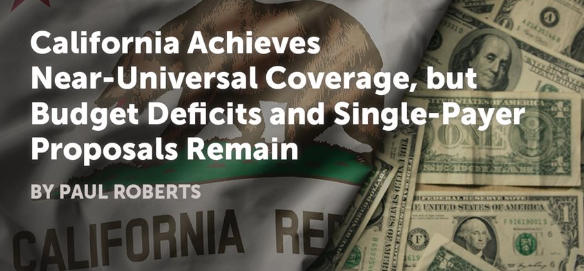California Achieves Near-Universal Coverage, But Budget Deficits And Single-Payer Proposals Remain
By Paul Roberts, REBC, Sr. Director of Education & Market Development
February 12, 2024

On January 1, 2024, California took a significant step toward achieving universal health coverage for its residents. By expanding its Medi-Cal program, the state now ensures that every resident, regardless of immigration status, has the opportunity to receive comprehensive medical services and health care coverage. This effectively achieves “near-universal coverage” within California’s borders.
Serving approximately 40% of all Californians, Medi-Cal, the state’s Medicaid program offering free or low-cost health coverage to income-eligible residents, historically excluded many undocumented immigrants. However, since 2016, the state has been steadily expanding coverage through its own funding. This included immigrant children first, then young adults, followed by adults ages 50 and older, and finally, in 2024, adults ages 26-49.
This latest expansion is estimated to cover an additional ~700,000 undocumented adults, bringing the total to nearly 1.4 million covered through these efforts. This significant step means that nearly all Californians, regardless of immigration status, now have access to health care and health insurance through various channels like employer-sponsored plans, the Covered California public exchange, Medi-Cal, Medicare, and others.
This achievement was not through a Single Payer system, which would replace all existing health care payers and access systems with one government-run program, but rather through an expansion of existing state programs. While the cost of this Medi-Cal expansion is not insignificant, it pales in comparison to the estimated $500 billion annual price tag of a Single Payer proposal, which is nearly double California’s current entire state budget.
Still, discussions in the California legislature continue regarding the introduction of a Single Payer system and overhaul of all health care, for all residents, within the state. One of the biggest obstacles in introducing a Single Payer system is financing it – in addition to logistics, a restructure of health care workers and hospital systems, medical tourism, and much more.
California Budgets – Health Care Abilities and Limitations
California’s budget process starts with a bit of a guessing game. By January 10th, the governor must propose a spending plan (a “budget”) for the upcoming fiscal year (July 1 – June 30), even though the California Franchise Tax Board doesn’t start gathering tax revenues until April 15th. This initial proposal, based on projections, sets the stage for lawmakers’ discussions, and identifies the administration’s fiscal projections and priorities. Once the tax season kicks in, things become clearer. In May, the governor revises the budget based on actual revenue, making adjustments as needed. Finally, by June 15th, the legislature must pass the final budget.
While federal budget debates often become gridlocked, California’s system, with its single-party dominance in 2/3+ of the legislature and statewide offices, typically avoids such impasses. However, some contentious budget items are often delayed and passed later in “budget-trailer bills” during the final hours before the legislature adjourns on August 31st. Despite its limitations, the governor’s initial proposal remains crucial for understanding the state’s available funding and sets the stage for negotiations and legislative items in the year ahead.
Governor Newsom’s budget proposal of $291.5 billion includes a $37.86 billion deficit, which is notably smaller than the Legislative Analyst’s Office’s projected $68 billion shortfall a few weeks prior. While the projected numbers differ, both clearly estimate a budget deficit of nearly $38 billion – or more.
In contrast, California’s state budget had a $100 billion surplus in 2022-2023. The current fiscal year 2023-2024 has a $31 billion deficit. In Newsom’s press conference for his budget announcement, he noted that the swings in California’s economy are heavily dependent on the wealthiest Californians’ personal income taxes, which fluctuate.
While budget deficits are never welcomed news, Governor Newsom highlighted natural budget cycles – but did not call for alarm. His budget focuses on “promises kept” in pillar areas like addressing homelessness, mental health, a safer California, climate change, wildfire mitigation, career education, and economic dominance.
Newsom’s Budget Summary includes highlights of priorities and budget solutions. His two-hour budget press briefing did not focus on health care, other than media questions about a need to revisit a health care worker wage increase, approved by SB 525 in 2023.
[READ FULL ARTICLE HERE]
